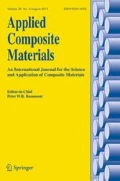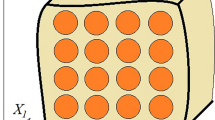Abstract
Analytically based model is presented for behavioral analysis of the plastic deformations in the reinforced materials using the circular (trigonometric) functions. The analytical method is proposed to predict creep behavior of the fibrous composites based on basic and constitutive equations under a tensile axial stress. New insight of the work is to predict some important behaviors of the creeping matrix. In the present model, the prediction of the behaviors is simpler than the available methods. Principal creep strain rate behaviors are very noteworthy for designing the fibrous composites in the creeping composites. Analysis of the mentioned parameter behavior in the reinforced materials is necessary to analyze failure, fracture, and fatigue studies in the creep of the short fiber composites. Shuttles, spaceships, turbine blades and discs, and nozzle guide vanes are commonly subjected to the creep effects. Also, predicting the creep behavior is significant to design the optoelectronic and photonic advanced composites with optical fibers. As a result, the uniform behavior with constant gradient is seen in the principal creep strain rate behavior, and also creep rupture may happen at the fiber end. Finally, good agreements are found through comparing the obtained analytical and FEM results.







Similar content being viewed by others
References
Cox, H.L.: The elasticity and strength of paper and other fibrous materials. Br. J. Appl. Phys. 3, 72–9 (1952)
Min, B.K., Crossman, F.W.: Analysis of creep for metal matrix composites. J. Compos. Mater. 16(3), 188–203 (1982)
Lauke, B., Schultrich, B.: Deformation behaviour of short-fibre reinforced materials with debonding interfaces. Compos. Sci. Technol. 19(2), 111–126 (1983)
Lee, Y.S., Batt, T.J., Liaw, P.K.: Stress analysis of a composite material with short elastic fibre in power law creep matrix. Int. J. Mech. Sci. 32(10), 801–815 (1990)
Beyerlein, I.J., Landis, C.M.: Shear-lag model for failure simulations of unidirectional fiber composites including matrix stiffness. Mech. Mater. 31(5), 331–350 (1999)
Zhang, J.: Modeling of the influence of fibers on creep of fiber reinforced cementitious composite. Compos. Sci. Technol. 63(13), 1877–1884 (2003)
Afonso, J.C., Ranalli, G.: Elastic properties of three-phase composites: analytical model based on the modified shear-lag model and the method of cells. Compos. Sci. Technol. 65(7–8), 1264–1275 (2005)
Ramezani, M., Hamed, E.: Coupled thermo-mechanical creep behavior of sandwich beams – modeling and analysis. Eur. J. Mech. A. Solid. 42, 266–27 (2013)
Shahidi, M., Pichler, B., Hellmich, C.: Viscous interfaces as source for material creep: a continuum micromechanics approach. Eur. J. Mech. A. Solid. 45, 41–58 (2014)
Ismar, H., Schröter, F., Streicher, F.: Inelastic behavior of metal-matrix composites reinforced with fibres of silicon carbide, alumina or carbon: a finite-element analysis. Compos. Sci. Technol. 60(11), 2129–2136 (2000)
Povirk, G.L., Needleman, A., Nutt, S.R.: An analysis of residual stress formation in whisker-reinforced Al/SiC composites. Mater. Sci. Eng. A 125(2), 129–140 (1990)
Levy, A., Papazian, J.M.: Elastoplastic finite element analysis of short-fiber-reinforced SiC/Al composites: effects of thermal treatment. Acta Metall. Mater. 39(10), 2255–2266 (1991)
Kim, K.J., Yu, W.R., Kim, M.S.: Anisotropic creep modeling of coated textile membrane using finite element analysis. Compos. Sci. Technol. 68(7–8), 1688–1696 (2008)
Lee, W.J., Son, J.H., Park, I.M., Park, Y.H.: Direct numerical predictions for the steady-state creep deformation of extruded SiCw/Al6061 composites using a representative volume element with random arrangement of whiskers. Comput. Mater. Sci. 48(4), 802–812 (2010)
Meng, Q., Wang, Z.: Extended finite element method for power-law creep crack growth. Eng. Fract. Mech. 127, 148–160 (2014)
Monfared, V., Daneshmand, S., Monfared, A.H.: Effect of atomic number and atomic weight on time-dependent inelastic deformation in metals. Kovove Mater. 53(2), 85–89 (2015)
Morimoto, T., Yamaoka, T., Lilholt, H., Taya, M.: Second stage creep of silicon carbide whisker/6061 aluminum composite at 573 K. J. Eng. Mater. Technol. 110, 70–76 (1988)
Meyer, D.W., Cooper, R.F., Plesha, M.E.: High-temperature creep and the interfacial mechanical response of a ceramic matrix composite. Acta Metall. Mater. 41(11), 3157–3170 (1993)
Boubakri, A., Haddar, N., Elleuch, K., Bienvenu, Y.: Influence of thermal aging on tensile and creep behavior of thermoplastic polyurethane. C. R. Méc. 339(10), 666–673 (2011)
Yang, X., Sun, Y., Shi, D.: Experimental investigation and modeling of the creep behavior of ceramic fiber-reinforced aerogel. J. Non-Cryst. Solids 358(3), 519–524 (2012)
Wang, X., Shi, J., Liu, J., Yang, L., Zhishen, W.: Creep behavior of basalt fiber reinforced polymer tendons for prestressing application. Mater. Des. 59, 558–564 (2014)
Guo, X., Lu, W., Wang, L., Qin, J.: A research on the creep properties of titanium matrix composites rolled with different deformation degrees. Mater. Des. 63, 50–55 (2014)
Naeem, M.: Implications of day temperature variation for an aero-engine’s HP turbine-blade’s creep life-consumption. Aerosp. Sci. Technol. 13(1), 27–35 (2009)
Schjødt-Thomsen, J., Pyrz, R.: Non-linear creep modelling of single-fibre model composites. Compos. Sci. Technol. 60(9), 1791–1800 (2000)
Kumar, S., Singh, R.N.: The creep response of uni-directional fiber-reinforced ceramic composites: a theoretical study. Compos. Sci. Technol. 61(4), 461–473 (2001)
Ohno, N., Ando, T., Miyake, T., Biwa, S.: A variational method for unidirectional fiber-reinforced composites with matrix creep. Int. J. Solids Struct. 39(1), 159–174 (2002)
Mileiko, S.T.: Steady state creep of a composite with short fibres. J. Mater. Sci. 5, 254–261 (1970)
Fukuda, H., Chou, T.W.: An advanced shear-lag model applicable to discontinuous fiber composites. J. Compos. Mater. 1(15), 79–91 (1981)
McLean, M.: Creep deformation of metal matrix composites. Compos. Sci. Technol. 23, 37–52 (1985)
Gao, X.L., Li, K.: A shear-lag for carbon nanotube-reinforced polymer composites. Int. J. Solids Struct. 42, 1649–1667 (2005)
Hsueh, C.H., Young, R.J., Yang, X., Becher, P.F.: Stress transfer in a model composite containing a single embedded fiber. Acta Mater. 45(4), 1469–1476 (1997)
Nayfeh, A.H., Abdelrahman, W.G.: Micromechanical modeling of load transfer in fibrous composites. Mech. Mater. 30, 307–324 (1998)
Monfared, V., Daneshmand, S., Reddy, J.N.: Rate dependent plastic deformation analysis of short fiber composites employing virtual fiber method. J. Comput. Sci. 10, 26–35 (2015)
Ruggles-Wrenn, M.B., Pope, M.T.: Creep behavior in interlaminar shear of a SiC/SiC ceramic composite with a self-healing matrix. Appl. Compos. Mater. 21(1), 213–225 (2014)
Sayyidmousavi, A., Bougherara, H., Fawaz, Z.: The role of viscoelasticity on the fatigue of angle-ply polymer matrix composites at high and room temperatures- a micromechanical approach. Appl. Compos. Mater. 22(3), 307–321 (2015)
Boyle, J.T., Spence, J.: Stress analysis for creep, 1st edn. Butterworth-Heinemann, Southampton, Butterworth (1983)
Khan, A.S., Huang, S.: Continuum theory of plasticity. John Wiley & Sons, New York (1995)
Sadd, M.H.: Elasticity: theory, applications, and numerics, 2nd edn. Academic, New York (2009)
Reddy, J.N.: An introduction to continuum mechanics, 2nd edn. Cambridge University Press, New York (2013)
Author information
Authors and Affiliations
Corresponding author
Rights and permissions
About this article
Cite this article
Monfared, V. Circular Functions Based Comprehensive Analysis of Plastic Creep Deformations in the Fiber Reinforced Composites. Appl Compos Mater 23, 1137–1149 (2016). https://doi.org/10.1007/s10443-016-9504-5
Received:
Accepted:
Published:
Issue Date:
DOI: https://doi.org/10.1007/s10443-016-9504-5




